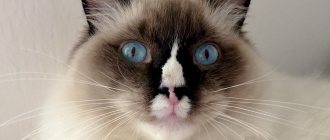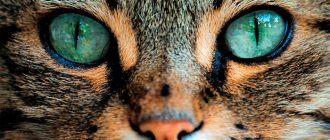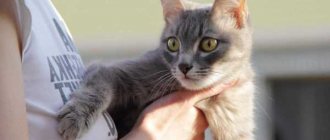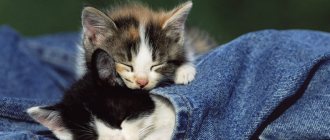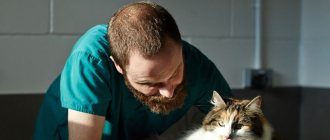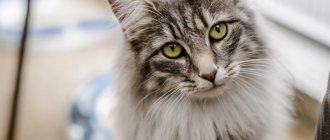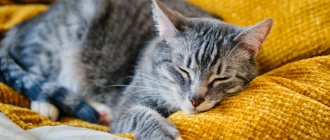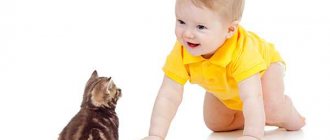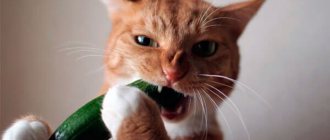It is not difficult to determine that your pet has become worse able to see or is completely blind. It is necessary to carefully monitor his condition and behavior. But you need not only to understand that the animal is blind, but also to find out what caused this condition.
Blindness does not always develop quickly. In some cases, against the background of serious pathologies, vision loss occurs gradually. Therefore, signs also appear slowly. It is worth remembering that blindness in a cat can be either reversible or irreversible. Blindness is also divided into partial and complete.
To know when to seek veterinary help, you need to monitor for symptoms.
Unsteady gait
First on the list of signs indicating the development of blindness in a cat is an unsteady gait. Owners of blind cats know firsthand that their pets, deprived of the ability to see normally, are able to live varied and quite happy lives. Remaining blind, the cat will not suffer, but will be able to adapt to life. The fact is that with age, all cats sooner or later begin to go blind as a result of the development of degenerative senile processes.
Domestic cats have human-like vision. The difference is the color of the image and twilight vision. Cats are not able to normally focus their gaze on nearby objects. At the same time, objects located at a distance are visualized much better. This explains the fact that a cat can be completely indifferent to its favorite toy that lies nearby.
For most people, after 40 years of age, their vision begins to rapidly deteriorate. Therefore, a person turns to an ophthalmologist, who prescribes the wearing of glasses, at least for reading. Domestic cats, after 5 years, begin to see worse. The reason for this is a change in the flexibility of the lens, causing clouding. This leads to a disruption in the ability to focus on objects, regardless of their location.
Vision problems that come on suddenly can cause a change in gait. Unsteady walking occurs in cases where vision loss is caused by sudden changes in the lens, vitreous body or retina.
Diagnosis of the condition
If you suspect vision problems, your cat should be seen by an ophthalmologist. In a specialized institution, a veterinary specialist will conduct a series of ophthalmological diagnostics to determine the cause of blindness. First of all, the doctor will do a visual examination using lighting and magnification . At this stage, disturbances in the retina, changes in the transparency of the media, and disturbances in the optic nerve can be detected.
After a visual examination, the doctor will use an ophthalmoscope to examine the internal structures of the animal’s eyes, provided they are transparent. Some modern clinics have video ophthalmoscopy , which documents the results of a study of the intraocular structures of the eye.
The research method allows us to identify the following causes of blindness: detachment and degenerative changes in the retina, including atrophy, neuritis, optic nerve tumor, arterial hypertension. To exclude glaucoma, the animal must undergo tonometry.
Modern methods for diagnosing ophthalmological diseases include electroretinography , which allows one to study the functions of the retina. The examination is especially informative if the ophthalmoscopic picture of the fundus is normal.
If necessary, the specialist will prescribe an ultrasound examination of the eyeball . The method is used to determine the position of the lens, the presence of various formations in the anterior chamber of the eye and the vitreous body, and damage to the retina.
Magnetic resonance imaging is often used as an additional diagnostic method . The study allows us to identify the presence of neoplasms and inflammatory processes in intraocular structures, as well as obtain a visual picture of brain tissue.
For the purpose of differential diagnosis, laboratory and biochemical methods of studying blood and urine are used to exclude diabetes mellitus, chronic renal failure and other concomitant diseases.
Frequent collisions with objects
Constantly bumping into objects. With a sudden loss of vision, the animal begins to collide not only with objects, but also with walls. In this regard, veterinary experts strongly do not recommend that owners of cats who have lost their vision make changes in the house.
If there is a lot of furniture in the house that has sharp corners, it is recommended to wrap them in something soft. Special film or devices are perfect for these purposes, the purpose of which is to protect furniture for small children who are just exploring the world.
Often colliding with objects, a blind animal will soon remember the route and automatically determine distances. Not all cats can remember distances and routes, so in this case they rely on their sense of touch. It is the whiskers that are very important for old and blind animals, playing the role of a kind of probe. Vibrissae allow the cat to determine at what distance an object is from the animal.
Signs of blindness in cats
The owner can understand that a cat has lost its vision only in the event of a sudden onset of pathology. With a gradual decrease in the acuity of vision of the surrounding world, the animal’s body has time to adapt to the new situation. Hearing, smell, and whiskers come to the rescue, and it is quite difficult to understand that something is wrong with a striped pet.
Veterinary ophthalmologists advise owners to pay attention to the following clinical signs of a developing disease:
- The animal's movements in a familiar room become cautious.
- In an unfamiliar place, a cat sits in place for a long time, without exploring the space. When trying to move, he bumps into objects, his movements are uncertain and clumsy.
- The animal does not jump.
- The gait changes, becomes cautious and uncertain.
- The gaze may be cloudy, without concentrating on a bright moving object.
- With one-sided blindness, a cat turns its head more often, trying to look at an object with its healthy eye.
- The animal begins to lead an inactive lifestyle: sleeps a lot, reluctantly takes part in games.
- When playing, the cat misses and misses the “prey.”
- Stops hunting mice and birds.
- The animal becomes timid, timidity and nervousness develop.
- Constantly monitoring the space with the help of its whiskers, a cat with poor vision often breaks them off.
When keeping a pet in an apartment without access to the street, it is very difficult to notice oddities in behavior. This is due to the fact that in a familiar and familiar space, animals remember well the location of furniture and objects and, with the help of other senses, are well oriented in their own walls.
Refusal to jump
A cat with poor vision refuses to jump in heights, jumping onto elevated surfaces as before. The reason for refusing to jump may be the inability to calculate the correct trajectory of the jump as a result of poor vision or blindness. But refusal to jump can also occur in the event of unsuccessful maneuvers, as a result of which the animal is injured. For a long time, a cat may refuse to jump from heights or onto elevated surfaces.
It is worth drawing the attention of cat owners to the fact that the reason for refusing to jump can be not only poor eyesight or injury, but also pain in the lumbar region. Also, the appearance of discomfort in the kidney area due to the development of various pathologies can cause the animal to refuse to jump.
In order to find out exactly the reason for this behavior in your pet, it is recommended to seek help from a veterinary specialist. After conducting a detailed examination of the animal and a number of necessary laboratory tests, the doctor will be able to find out the cause and prescribe treatment if necessary.
What to do to restore the animal's ability to see?
Drug treatment of pathology depends on the causes of its occurrence, in some cases they resort to surgery.
The treatment regimen depends entirely on the established diagnosis. If the cause of blindness is inflammatory processes in the body, a course of antibiotics and anti-inflammatory drugs is prescribed. For glaucoma, therapy is aimed at reducing ICP; normalizing blood pressure will be necessary if hypertension is the root cause of the pathology. For cataracts at the initial stage of development, the doctor prescribes special ophthalmic drops; if the disease is advanced, you will have to undergo surgery to replace the lens.
Problems with coordination
A lack of coordination may indicate that the animal has become blind or has become much worse in vision. In scientific circles, loss of coordination of movements is called ataxia. This phenomenon does not affect the intellectual abilities of the animal, but characterizes damage to the tissues of the nervous system.
It is very important to monitor your pet if the owner notices the animal has problems with coordination. In addition to problems with the visual organs, ataxia can occur with:
- Cerebellar injuries due to falls. In addition to impaired coordination of movements, the cat develops tremors during any movements.
- Damage to the structures of the inner ear. Vestibular ataxia in cats can be caused by otitis media or tumor processes in the inner ear.
leave a comment
*This page refers to the section on cats' eyes.
Sudden blindness
- a very alarming and unpleasant disease of cats. Affected cats, without sufficient time to adapt, experience severe disorientation and may behave in strange and unusual ways. A cat can move haphazardly, crash into various objects, and be constantly in a state of stress. The matter is complicated by the fact that the resulting blindness is not always obvious to the owner, and can be identified by a veterinarian when determining the reasons for the cat’s strange behavior.
One noticeable sign of a cat's blindness is that the pupils (the dark central part of the eye) become permanently dilated.
Lack of eye glow in the dark
Being predators, cats are able to see well at dusk. In order to see better, there is a special mirror layer on the retina, which gives the animal’s eyes a special greenish or reddish glow. All cats with yellow or greenish eyes will have a green glow, but those with naturally blue eyes will glow red in the dark.
The reason for the lack of glow in a cat’s eyes at night may be cataracts. Many older cats are susceptible to this disease. Pathological processes affect the lens, making it cloudy. The cause of the development of cataracts and subsequent loss of vision in a cat can be:
- serious injuries to the visual organs;
- genetically determined disorders;
- development of diabetes mellitus.
Broken mustache
Whiskers or vibrissae are necessary for cats to navigate well in space. Mainly thanks to the whiskers, even a completely blind cat can feel good, knowing where the owners are, how furniture and other objects are arranged.
Nerve impulses enter the brain from the vibrissae, allowing the brain to draw a picture of the surrounding world. If you try to touch a cat's whiskers, it will completely reflexively close its eyes. This safety measure is necessary in order to protect the animal’s eyes in the dark from possible branches or blades of grass.
A cat's whiskers are more than just whiskers. They are supplied with blood and have nerve endings that lead directly to the trigeminal nerve. Related to this is the fact that the slightest vibration of air, the picture will be transmitted to the brain in the form of nerve impulses. A cat that has gone blind begins to shake its head, trying to identify the picture around it. This leads to damage to the vibrissae. But a broken mustache can indicate more than just vision loss. The cause of brittle cat whiskers can be:
- malnutrition – lack of vitamin-mineral complexes, biotin and calcium in the diet;
- the presence of parasites in the body;
- diseases of fungal or bacterial origin;
- systemic dermatitis.
In this regard, to determine the cause of broken whiskers, it is necessary to consult a veterinarian.
